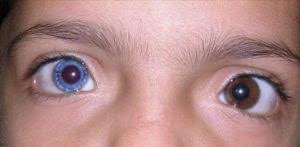 Autosomal dominant disorder associated with pigmentary variations that include white eyelashes, a frontal white lock of hair, heteroiridis, wide bridge of the nose and cochlear deafness.
Autosomal dominant disorder associated with pigmentary variations that include white eyelashes, a frontal white lock of hair, heteroiridis, wide bridge of the nose and cochlear deafness.
Waardenburg Syndrome (WS) is a rare genetic disorder that affects the pigmentation of the skin, hair, and eyes, and can also cause hearing loss.
WS is caused by mutations in certain genes that play a role in the development of embryonic cells, which in turn affects the formation and migration of neural crest cells during embryonic development.
Neural crest cells create many of the body’s tissues and organs, including the melanocytes that produce skin and eye pigment, the inner ear, and other structures.
The symptoms of WS vary but typically include distinctive facial features, such as an abnormal widening of the distance between the inner corners of the eyes, a prominent nasal bridge, and an unusually high and broad forehead.
Individuals with WS may also have pale blue eyes or eyes that are two different colors, along with patches of white hair, albinism, or early graying.
Affects about 1.4% of congenitally deaf children with an overall incidence of one in 42,000.
Hearing loss is another common symptom of WS, which may range from mild to severe.
There are four main types of WS, each with different genetic mutations and a range of associated symptoms.
There is no cure for WS, but treatments can be tailored to the individual based on their specific symptoms and can include hearing aids, cochlear implants for more severe hearing loss, surgeries to correct physical abnormalities, and genetic counseling.
Affects about 1.4% of congenitally deaf children with an overall incidence of one in 42,000.
There are at least four types of syndromes: the type is determined based on the patient’s physical characteristics.
Rarely maybe associated with intestinal disorders, elevation of the shoulder blade, and spinal disorders.
Four different genes have been identified PAX 3, MITF, EDNRB, and EDN3.
PAX3 is the most common type and is located on chromosome 2.
50% likelihood that a child of a person with this syndrome with also have this syndrome.
